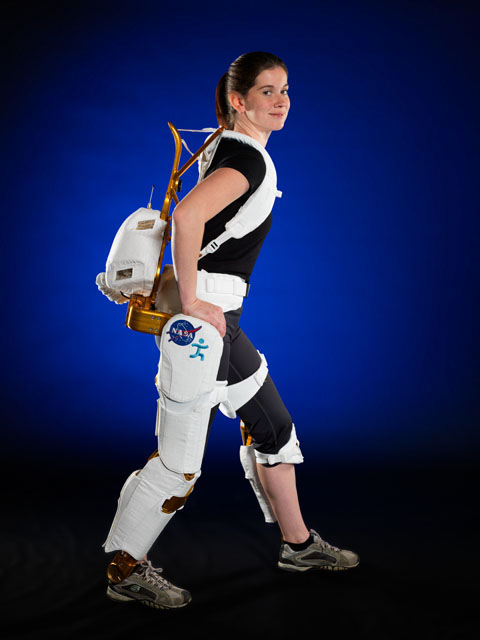Filtered By: Scitech
SciTech
NASA 'Ironman' suit can be real-life hero for astronauts, paraplegics
No, it won't make a wearer do insane aerial stunts or fire repulsor rays. But it can help astronauts maintain their health while in space, and better yet, help paraplegics walk.
This in a nutshell is the National Aeronautics and Space Administration's (NASA's) X1 robotic exoskeleton, which uses the latest in robotic and space technology.

NASA Project Engineer Shelley Rea demonstrates the X1 Robotic Exoskeleton. (Photo: Robert Markowitz)
"Worn over the legs with a harness that reaches up the back and around the shoulders, X1 has 10 degrees of freedom, or joints -- four motorized joints at the hips and the knees, and six passive joints that allow for sidestepping, turning and pointing, and flexing a foot. There also are multiple adjustment points, allowing the X1 to be used in many different ways.," NASA said.
NASA and The Florida Institute for Human and Machine Cognition (IHMC) of Pensacola, Florida developed the 57-pound X1 with the help of engineers from Oceaneering Space Systems of Houston.
X1 is actually a robot that a human could wear over his or her body to assist or inhibit movement in leg joints.
When in inhibit mode, the device can be an in-space exercise machine that will supply resistance against leg movement.
But it could also be used in reverse on the ground, "potentially helping some individuals walk for the first time."
Michael Gazarik, director of NASA's Space Technology Program, said robotics is playing a key role aboard the International Space Station "and will continue to be critical as we move toward human exploration of deep space.
Helping people walk again
"What's extraordinary about space technology and our work with projects like Robonaut are the unexpected possibilities space tech spinoffs may have right here on Earth. It's exciting to see a NASA-developed technology that might one day help people with serious ambulatory needs begin to walk again, or even walk for the first time. That's the sort of return on investment NASA is proud to give back to America and the world," he added.
For now, NASA said X1 is in research-and-development phase, where the primary focus is design, evaluation and improvement of the technology.
NASA is looking at the potential for the X1 as an exercise device to improve crew health both aboard the space station and during future long-duration missions to an asteroid or Mars.
"Without taking up valuable space or weight during missions, X1 could replicate common crew exercises, which are vital to keeping astronauts healthy in microgravity. In addition, the device has the ability to measure, record and stream back, in real-time, data to flight controllers on Earth, giving doctors better feedback on the impact of the crew's exercise regimen," NASA said. Power boost
Future uses for the X1 may include a robotic power boost to astronauts as they work on the surface of distant planetary bodies.
If coupled with a spacesuit, X1 could provide additional force when needed during surface exploration, improving the ability to walk in a reduced gravity environment, "providing even more bang for its small bulk," NASA said.
On Earth, IHMC is eyeing developing and using X1 as an assistive walking device.
"By combining NASA technology and walking algorithms developed at IHMC, X1 has the potential to produce high torques to allow for assisted walking over varied terrain, as well as stair climbing. Preliminary studies using X1 for this purpose have already started at IHMC," NASA said.
"We greatly value our collaboration with NASA. The X1's high-performance capabilities will enable IHMC to continue performing cutting-edge research in mobility assistance while expanding into the field of rehabilitation," said Ken Ford, IHMC's director and CEO.
Further potential
Other potential applications for X1 include rehabilitation, gait modification and offloading large amounts of weight from the wearer.
NASA said preliminary studies by IHMC showed X1 to be "more comfortable, easier to adjust, and easier to put on than previous exoskeleton devices."
"Researchers plan on improving on the X1 design, adding more active joints to areas such as the ankle and hip, which will, in turn, increase the potential uses for the device," it said. — TJD, GMA News
More Videos
Most Popular



